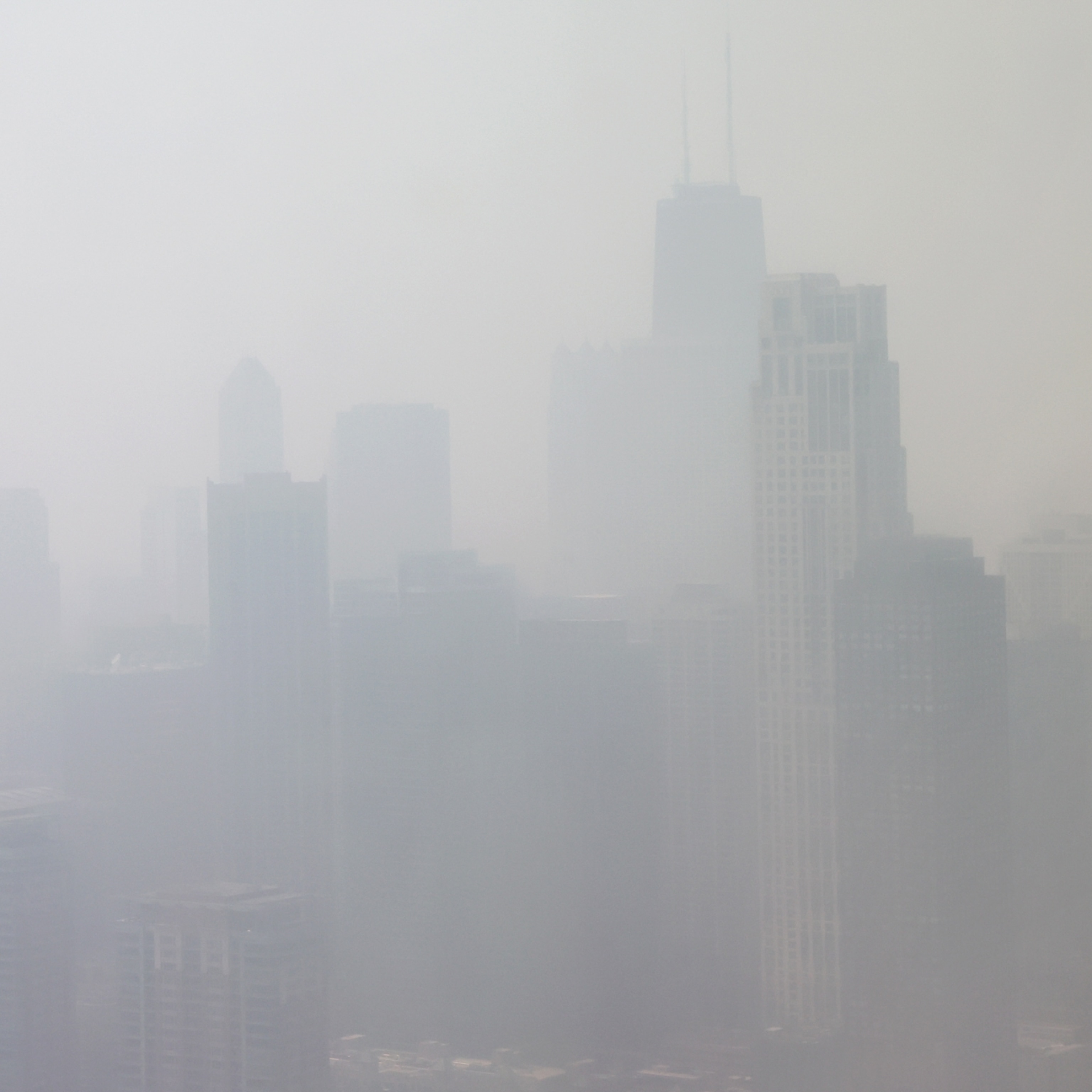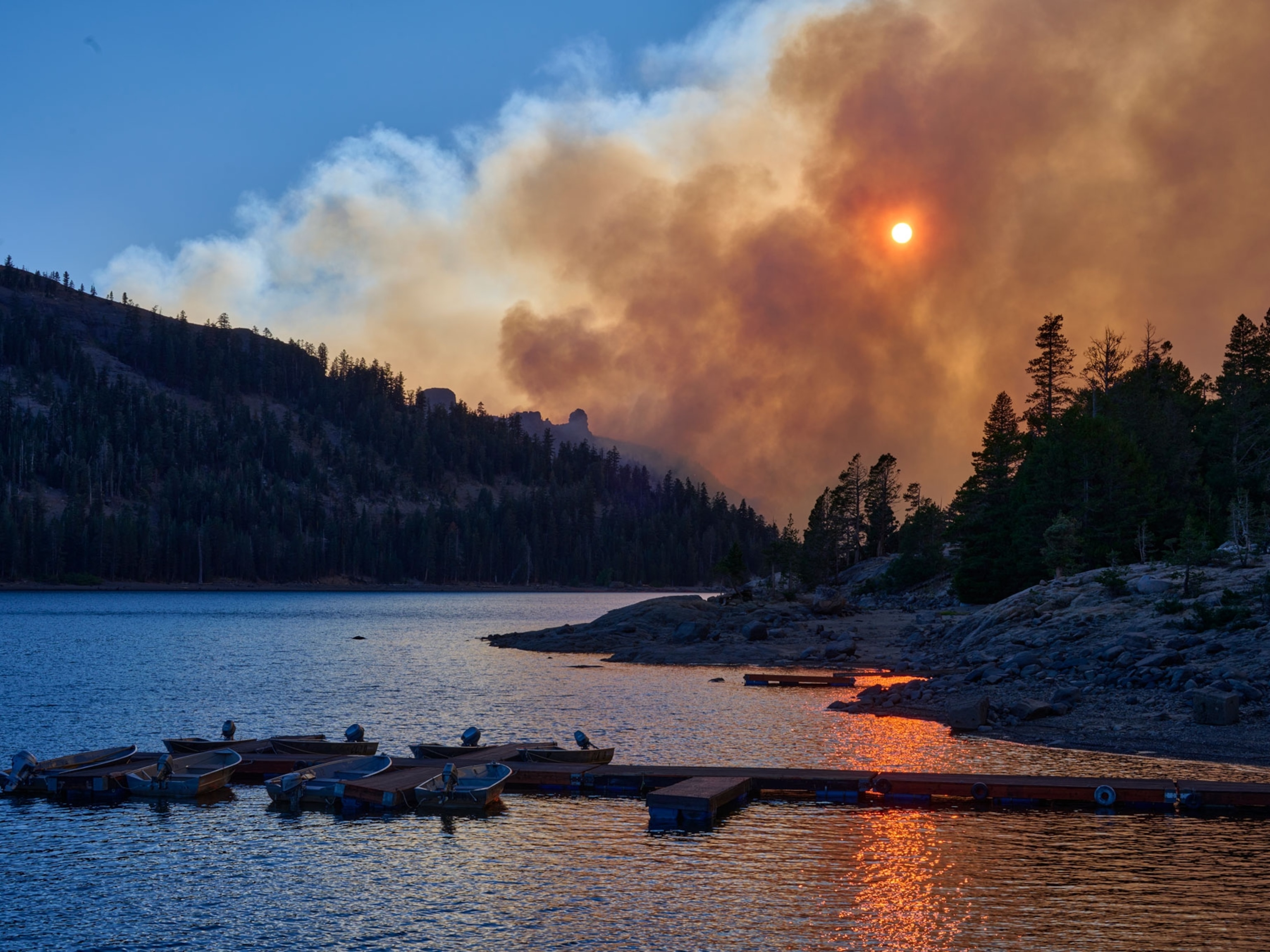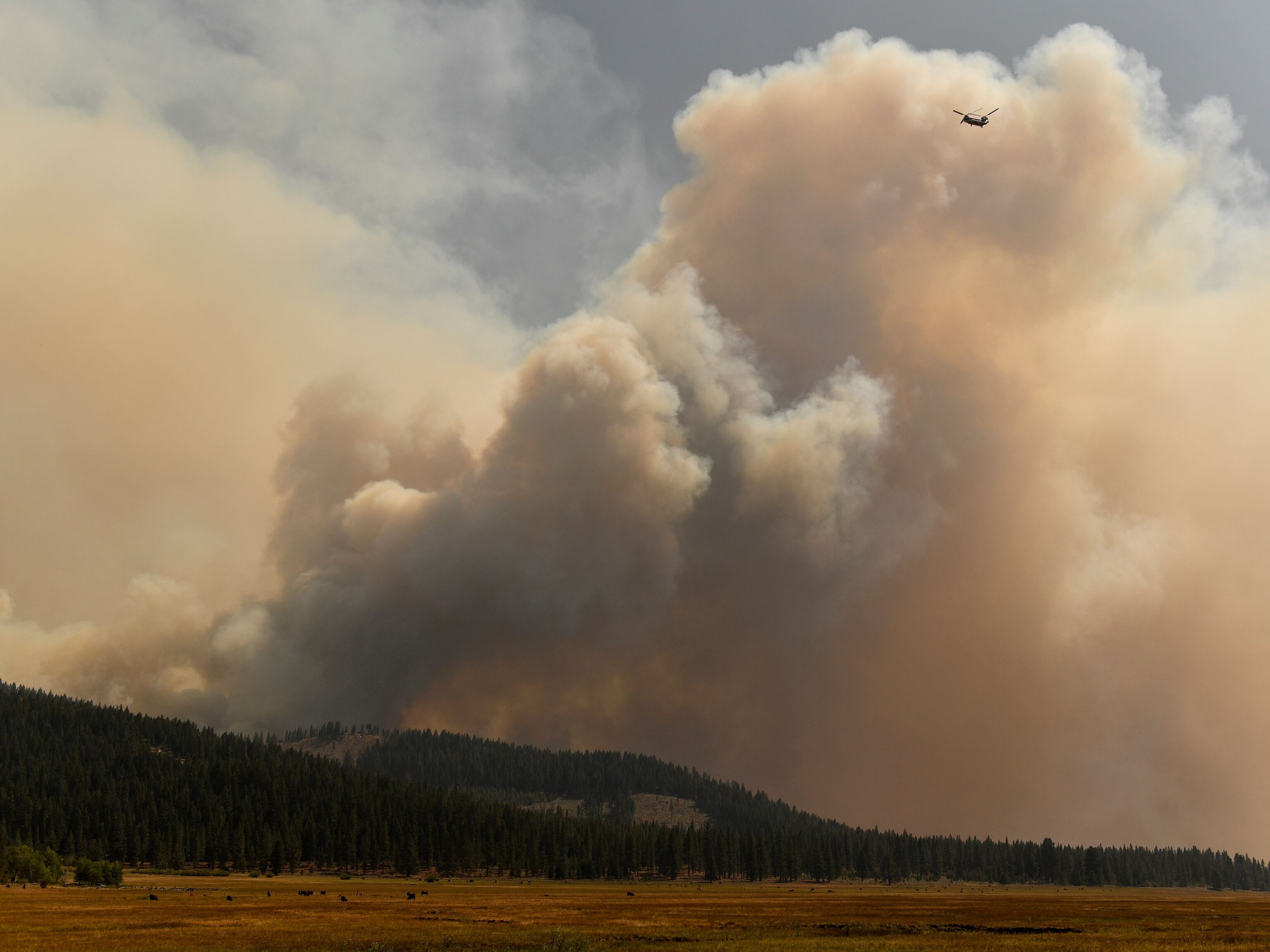
How wildfire smoke affects your body—and how you can protect yourself
The chronic exposure to longer-lasting, more frequent wildfires could have serious effects on our health—from our lungs to our kidneys, liver, brain, and heart.
On Tuesday evening, New York City had some of the worst air quality in the world. The pollution was the result of smoke from Canadian wildfire smoke dispersing and placing millions of people under air quality alerts.
Wildfire smoke contains a variety of gases and particles from the materials that fuel the fire, including ozone, carbon monoxide, polycyclic aromatic compounds, nitrogen dioxide, and particulate matter—pollutants linked to respiratory and cardiovascular illnesses, according to a study in the Journal of the American Heart Association.
When a healthy person breathes in air tinged with smoke from the fires, they may feel a sting in their eyes, and when they cough, they may have trouble recovering their breath. But what happens to that same individual when they breathe smoky air for extended periods every year is still unclear.
“People were once exposed once or twice in a lifetime,” says Keith Bein, an atmospheric scientist at the University of California, Davis. “Now it’s happening every summer and for longer.”
In the United States, air quality is measured on a color-coded scale known as the Air Quality Index (AQI), which was established in 1977 as part of the Clean Air Act. Stretching from 0 to 500, the AQI is split across six categories—from good to hazardous. Its scale measures the levels of five major pollutants: ground-level ozone, carbon monoxide, sulfur dioxide, nitrogen dioxide, and particulate matter.
(Learn more about how to interpret your air quality forecast.)
State and local agencies in cities with populations over 350,000 are required to report these levels daily. The pollutants are measured both by instruments on the ground and satellites that constantly collect information about what’s in the atmosphere—including the particles from wildfires.

Impact on the human body
“Wildfire smoke is a very complex type of air pollution,” says Sarah Henderson, an environmental health scientist at the University of British Columbia. “It has many different gases in it, and the composition of those small particles can be highly variable, depending on what’s burning [and] how hot it’s burning.”
Of particular concern, she says, is particulate matter 2.5 microns in diameter—also referred to as PM 2.5. Those small particles, and ones even smaller, are capable of penetrating deep into a person’s lungs. Henderson says the body responds by releasing the same immune cells it would deploy to attack a virus. Unlike a virus, however, particulate matter isn’t broken down by that immune response and results in long-lasting inflammation.
“That inflammation affects your lungs, kidneys, liver, and probably your brain,” says Henderson.
Wildfires are a growing health threat, and Henderson says more evidence is needed to show exactly how wildfire smoke affects organs after long-term exposure.
“We don’t have a clear understanding of what the health effects are on an unborn fetus, but systemic inflammation in a woman who is pregnant may affect her unborn baby,” adds Henderson.
When wildfire smoke enters the airway, the tiny particles that it contains—which are about 30 times smaller than a human hair—can get lodged deep in the lungs and injure the lining. The body kicks into gear to dispel the foreign invaders, triggering spontaneous reflexes like coughing that helps cilia, the little hairs lining the cells of the airway, beat the particles out.
But the immune cells can’t break down the particulate matter—which only makes them work harder to try to defeat it, resulting in even more inflammation, says Stephanie Christenson, assistant professor of pulmonology at University of California, San Francisco.
Inflammation can be a good thing for fighting off invaders. But Christenson says it’s especially dangerous for anyone with underlying conditions such as asthma or COPD, both characterized by inflammation. Additional inflammation can exacerbate those diseases. “It’s a really delicate balance before you can go overboard,” she says.
With those diseases, it can be harder to get much-needed oxygen to the rest of the body. As oxygen enters the lungs it heads to the alveoli—tiny air sacs that form a thin barrier between the air and blood—and passes into the blood in the capillaries. When the body is fighting off a threat, those air sacs can fill up with mucus so that air cannot pass through, Christenson says. This also makes it more difficult for the body to eliminate the carbon dioxide, which can also cause respiratory distress.
There’s some evidence that the particles themselves can break through that barrier in the capillaries, getting into the bloodstream and causing an inflammatory response throughout the body.
While respiratory problems may be the most acute response to smoke inhalation, others are less obvious. In 2018, a study in the Journal of the American Heart Association found that smoke from the 2015 wildfires that scorched more than 893,000 acres of California was associated with cardiovascular issues and problems with blood flow to the brain in 361,087 emergency department visits between May 1 and September 30.
Karol Watson, professor of cardiology at the David Geffen School of Medicine at UCLA, links that to the proximity of the heart and coronary arteries to the lungs. Watson was part of a team that conducted a 2016 study published in The Lancet that looked at the effects of a variety of pollutants in six U.S. cities and discovered a link between high levels of air pollution and coronary disease.
Underlying conditions again are particularly worrisome when it comes to the damage wildfire smoke can inflict on the heart, Watson says. Heart attacks happen when the plaque building up in the arteries ruptures, and while Watson says researchers don’t believe the particulate matter causes this buildup, it can destabilize existing plaque, causing it to rupture.
There’s also some evidence that air pollution can trigger irregular heart rhythms, Watson says, although there’s less known about why this might happen.
Potential to worsen infections
According to the Centers for Disease Control, exposure to wildfire smoke can prevent a person from fighting off respiratory diseases like COVID-19.
“Higher air pollution is associated with respiratory effects and people being more prone to having respiratory illnesses,” says Irva Hertz-Picciotto, director of Environmental Health Sciences Core Center at the University of California, Davis. “To the extent that the immune system is compromised and cannot fight off viruses, air pollution exacerbates that.”
One study published in the journal Environmental International found exposure to wildfire smoke in the summer correlated with three to five times more flu cases later in the year.
Tarik Benmarhia, an environmental health scientist from the University of California, San Diego, notes that the same populations of people who were more vulnerable to diseases like COVID-19—those with low incomes, pre existing conditions, and poor access to health care—may also be vulnerable to the impacts of wildfires.
A 2017 study in the American Journal of Epidemiology found that elderly Black people who are more likely to live in urban areas, where there is persistent air pollution, were more likely to be hospitalized from exposure to wildfire smoke.
New toxins in smoke
In addition to the health impacts, discovering exactly what people are breathing in is also an emerging concern among scientists.
Wildfire smoke was once primarily made of the earthy remains of fallen twigs, brush, and trees, but as wildfires increasingly blaze through suburbs, they’re burning up the synthetic paints, carpets, and consumer goods that fill homes. In California’s historic 2018 fires, 19,000 homes burned.
(Learn more about the search to understand what's in wildfire smoke.)
Bein says samples of wildfire smoke over the past five years show that for as many compounds in the smoke they can identify, there are even more that they can’t.
“I don’t think we’ve had resolution on the exposure side to see what all those chemicals are and what happens when they combust at very high temperatures,” says Hertz-Picciotto, “nor do we understand how those health impacts might differ.”
How to protect yourself
The CDC recommends staying indoors to avoid wildfire smoke.
HVAC systems can help purify air inside a home, as can air purifiers for a single room.
“If you have a room you can keep cool, close the windows, doors, then run a portable air cleaner with a HEPA filter,” says Henderson.
It’s important to not add to indoor pollution by cooking with gas, frying food, smoking, or even vacuuming, says the CDC. If forced to venture outside, the CDC also recommends wearing an N95 respirator tightly fitted to your face: COVID-19 surgical masks and other homemade face coverings won’t protect you from the smoke.
(This is how animals escape from wildfire.)
“At the end of the day there’s only so much you can do,” says Bein, emphasizing that long-term planning must attempt to mitigate wildfires. New policies around prescribed burns as well as where homes can be built and what sort of features those homes should come with are solutions stakeholders need to tackle, Bein says.
“I think that’s going to be one of humanity's greatest challenges,” he says. “Not just wildfires but all the extreme events resulting from climate change. We are entering a new phase of reality we just can’t reverse.”
Related Topics
You May Also Like
Go Further
Animals
- This ‘saber-toothed’ salmon wasn’t quite what we thoughtThis ‘saber-toothed’ salmon wasn’t quite what we thought
- Why this rhino-zebra friendship makes perfect senseWhy this rhino-zebra friendship makes perfect sense
- When did bioluminescence evolve? It’s older than we thought.When did bioluminescence evolve? It’s older than we thought.
- Soy, skim … spider. Are any of these technically milk?Soy, skim … spider. Are any of these technically milk?
- This pristine piece of the Amazon shows nature’s resilienceThis pristine piece of the Amazon shows nature’s resilience
Environment
- This pristine piece of the Amazon shows nature’s resilienceThis pristine piece of the Amazon shows nature’s resilience
- Listen to 30 years of climate change transformed into haunting musicListen to 30 years of climate change transformed into haunting music
- This ancient society tried to stop El Niño—with child sacrificeThis ancient society tried to stop El Niño—with child sacrifice
- U.S. plans to clean its drinking water. What does that mean?U.S. plans to clean its drinking water. What does that mean?
History & Culture
- Meet the original members of the tortured poets departmentMeet the original members of the tortured poets department
- Séances at the White House? Why these first ladies turned to the occultSéances at the White House? Why these first ladies turned to the occult
- Gambling is everywhere now. When is that a problem?Gambling is everywhere now. When is that a problem?
- Beauty is pain—at least it was in 17th-century SpainBeauty is pain—at least it was in 17th-century Spain
- The real spies who inspired ‘The Ministry of Ungentlemanly Warfare’The real spies who inspired ‘The Ministry of Ungentlemanly Warfare’
Science
- Here's how astronomers found one of the rarest phenomenons in spaceHere's how astronomers found one of the rarest phenomenons in space
- Not an extrovert or introvert? There’s a word for that.Not an extrovert or introvert? There’s a word for that.
- NASA has a plan to clean up space junk—but is going green enough?NASA has a plan to clean up space junk—but is going green enough?
- Soy, skim … spider. Are any of these technically milk?Soy, skim … spider. Are any of these technically milk?
Travel
- What it's like to hike the Camino del Mayab in MexicoWhat it's like to hike the Camino del Mayab in Mexico
- Is this small English town Yorkshire's culinary capital?Is this small English town Yorkshire's culinary capital?
- This chef is taking Indian cuisine in a bold new directionThis chef is taking Indian cuisine in a bold new direction







